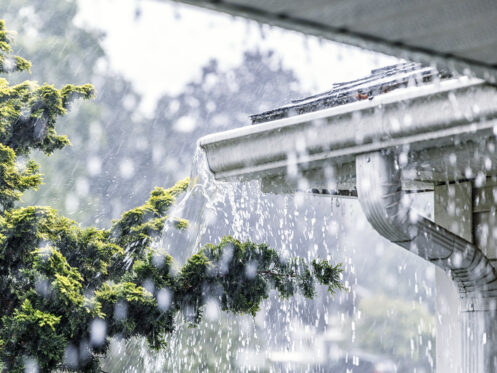Living in Arizona means getting used to the heavy rains that come with the monsoon season each year. While the rainfall can be beneficial in some ways, it also brings a range of plumbing challenges for homeowners. Some of these problems can cause serious damage if not addressed promptly. That’s why it’s important to understand what to watch for and when it’s time to call a professional plumber.
1. Slow Drains
In some older municipalities, stormwater and sewage still flow through a shared combined sewer system. During heavy monsoon rains, these systems can become overwhelmed as they try to handle both runoff and regular household wastewater. When the mains reach capacity, the excess pressure can push water and debris backward into your home’s sewer line.
This backflow doesn’t always lead to flooding, but it can cause clogs to form deeper in the line. This happens when leaves, silt, or other debris get pushed into your home’s sewer line. As the blockage worsens, your drains may begin to empty more slowly than usual. Toilets might struggle to flush completely. Over time, you may also hear gurgling sounds in your pipes or notice foul odors coming from drains, which often indicate a growing obstruction in the system.
If several drains in your home are slowing down at once, it’s a strong sign that the problem lies in the main sewer line rather than just a single fixture. After a storm during monsoon season, you may need to contact us to clear your sewer line. Our technicians use non-invasive methods like hydro-jetting, which allows us to solve the problem without digging up your lawn.
2. Sewage Backups
A more serious plumbing concern during monsoon season than slow drains is the risk of a sewage backup. When too much rain overwhelms the municipal sewer system, it can push untreated wastewater back through the pipes and into your home. This backflow may emerge from floor drains, showers, or even toilets, creating a significant health hazard and potentially causing extensive property damage.
Fortunately, there are preventive measures homeowners can take. One of the most effective is installing a backflow preventer. This device sits inside your home’s main sewer line and acts as a one-way gate. Under normal conditions, the flap remains open to let wastewater exit freely. But if sewage starts moving in the wrong direction, like back toward your home, the flap closes automatically to block it.
3. Broken or Damaged Underground Pipes
The ground can become so saturated during heavy rainfall that it shifts or compacts, placing pressure on underground plumbing. In some cases, this pressure is enough to crack or collapse sewer lines. This risk is particularly high in older homes that still rely on brittle cast iron or clay pipes. A damaged sewer line often causes symptoms like persistent slow drains, recurring clogs, or sewage backups.
Monsoon rains can also impact the underground water main that supplies your home. When the soil shifts or swells, it can lead to cracks in the water line. This usually results in a noticeable drop in water pressure or, in more severe cases, a complete loss of water. Pools of standing water in your yard, especially when there’s no clear source, can also point to a main water line break.
In some parts of the country, like Arizona, many homes are built on concrete slab foundations with water and drain lines buried beneath the slab. When rain-soaked soil settles or moves, it can strain these pipes and lead to what’s known as a slab leak. These are especially difficult to detect early on, but signs can include unexplained damp spots on floors, the sound of running water when fixtures are off, or a sudden spike in your water bill.
When a slab leak is suspected, our plumbers begin by using specialized leak detection tools that help pinpoint the exact location of the problem without having to tear up your floors. Rerouting the affected section of piping is often the most practical solution. This is especially true if the existing pipes are corroded or the leak is in a hard-to-reach area. In other cases, we may recommend trenchless pipe repair or tunneling beneath the foundation to access and replace damaged lines directly.
4. Flooding
If your home has a basement, it’s common for the lowest part to flood during heavy monsoon rains. When the soil around the foundation becomes overly saturated, water pressure can build and force moisture through cracks in the concrete, eventually seeping into the home. That’s why many homes in monsoon-prone areas are equipped with sump pumps. They automatically remove water collecting beneath the foundation and help prevent flooding.
As groundwater accumulates in the sump pit or basin, the pump activates to discharge the water safely away from the home. However, sump pumps typically have a lifespan of five to 10 years and, sometimes, can fail without warning. Regular testing and professional maintenance are essential, especially before monsoon season.
To test your sump pump, pour water into the basin to see if it activates. If the pump doesn’t turn on or makes loud or unusual noises, it’s time to contact us for inspection or replacement. It’s also a good idea to check the sump pump’s emergency backup battery if your system includes one. This is important since power outages often occur during severe storms.
5. Overflowing Outdoor Drains
Monsoon rains often overwhelm outdoor drainage systems, especially if they haven’t been maintained recently. Many homes have surface drains in patios, driveways, or yards that are designed to help direct rainwater away from the property. When these drains become clogged with leaves, silt, or yard debris, water can begin to back up. This often results in water pooling near the foundation, which increases the risk of it seeping into the home or causing long-term damage to the structure.
Blocked outdoor drains can also lead to water pooling around walkways, garages, and entryways. This is not only a hassle but can damage landscaping or allow contaminated stormwater to flow toward your home. In some cases, the water can also damage outdoor HVAC equipment like your central air conditioner condenser. If pools of water are left to stagnate, they may also produce unpleasant odors that will make their way into your home.
The best way to avoid this issue is to have your outdoor drains inspected and cleared by one of our professionals before the rainy season begins. Our plumbers can remove stubborn blockages, flush out the system, and ensure all your outdoor drainage is working as it should.
Contact Your Local Professionals
At Delta Mechanical, we’ve been serving homeowners in Mesa, AZ and the surrounding communities since 1995. Our licensed plumbers are experienced in addressing the unique plumbing challenges that come with Arizona’s monsoon season. Whether you need help preparing your plumbing ahead of time with a sump pump or reliable repairs after a storm, we’re here to help protect your home. Contact us today to schedule an appointment with one of our knowledgeable team members.


